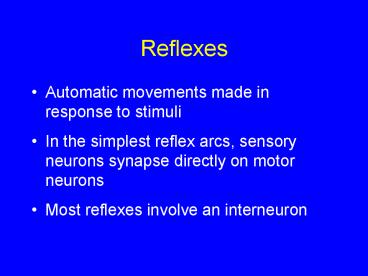Reflexes - PowerPoint PPT Presentation
1 / 14
Title: Reflexes
1
Reflexes
- Automatic movements made in response to stimuli
- In the simplest reflex arcs, sensory neurons
synapse directly on motor neurons - Most reflexes involve an interneuron
2
Stretch Reflex
STIMULUS Biceps stretches.
sensory neuron
motor neuron
RESPONSE Biceps contracts.
3
Sensory Receptors
- Convert the energy of a stimulus into action
potentials
Mechanoreceptors Thermoreceptors Pain
receptors
Chemoreceptors Osmoreceptors Photoreceptors
4
Somatic Sensations
- Touch
- Pressure
- Temperature
- Pain
- Motion
- Position
5
Smell
- A special sense
- Olfactory receptors
- Receptor axons lead to olfactory lobe
olfactory bulb
receptor cell
6
Taste
- A special sense
- Chemoreceptors
- Five primary sensations
- sweet, sour, salty, bitter, and umami
7
Balance and Equilibrium
- Organs of equilibrium are located in the inner ear
semicircular canals
utricle
saccule
vestibular apparatus
8
Properties of Sound
- Ear detects pressure waves
- Amplitude of waves corresponds to perceived
loudness - Frequency of waves (number per second)
corresponds to perceived pitch
9
Anatomy of Human Ear
stirrup
auditory nerve
anvil
hammer
auditory canal
eardrum
cochlea
10
Sound Reception
- Sound waves make the eardrum vibrate
- Vibrations are transmitted to the bones of the
middle ear - The stirrup transmits force to the oval window of
the fluid-filled cochlea
11
Sound Reception
- Movement of oval window causes waves in the fluid
inside cochlear ducts
oval window (behind stirrup)
scala vestibuli
eardrum
round window
scala tympani
12
Sound Reception
hair cells in organ of Corti
lumen of cochlear duct
tectorial membrane
basilar membrane
to auditory nerve
lumen of scala tympani
13
Vision
- Sensitivity to light does not equal vision
- Vision requires two components
- Eyes
- Capacity for image formation in the brain
14
Human Eye
sclera
retina
choroid
iris
fovea
optic disk
lens
pupil
cornea
part of optic nerve
aqueous humor
ciliary muscle
vitreous body































